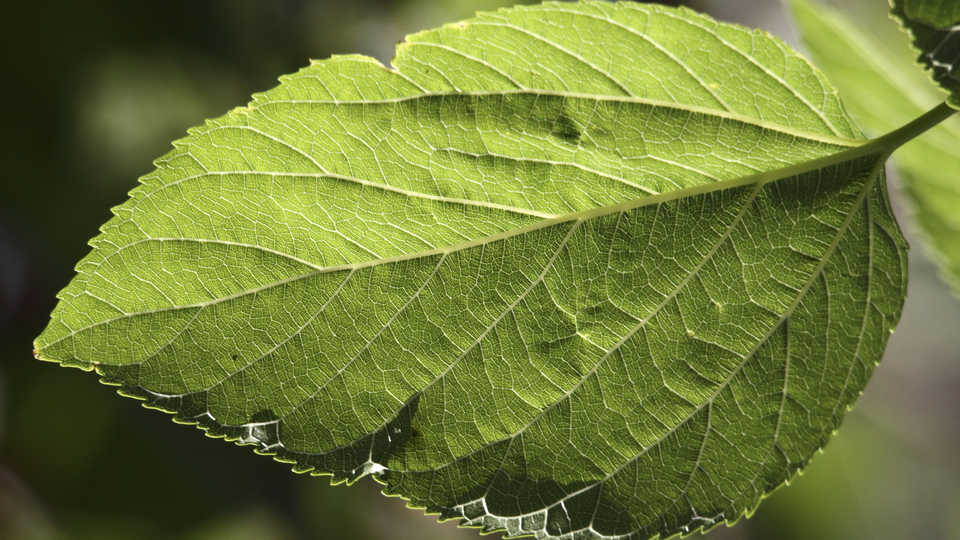In this activity, students will:
- observe the structures that make up the surface of a leaf.
- find the pores, called stomata, that let gasses in/out of a leaf.
- explore the ways that plants gain mass.

"Backlit Leaf" © 2011 Threthny
Plants have many crucial roles on our planet, and among these is the gas exchange that happens within their leaves. As plants take in carbon dioxide from our atmosphere, they release oxygen and retain the carbon. In this lesson, students will investigate leaves up close to look for the structures responsible for gas exchange.
In this activity, students will:
Note: some leaves are quite large and can take a lot of time to try and see the whole leaf. To speed things up, have students examine only what appears in one frame of the microscope.
Keep a parking lot with questions that arise during the discussion. Then as a class, see if you can answer some of those questions with further investigation using the microscopes, leaves and nail polish.
Stomata
Stomata are responsible for allowing gas exchange between the inside of the leaf and the atmosphere. Stoma is the singular and stomata is the plural form. When viewed with a microscope, they often look like coffee beans. There are more than 32 stomata in the image of the Western Sword Fern leaf, to the right. Carbon dioxide (CO₂), oxygen (O₂) and water (H₂0) commonly move in or out via the stomata.
While gas exchange occurs, carbon (C) stays inside the leaf as a building block for the plant. Often, stomata are open during the day when photosynthesis is taking place and closed at night when it stops. By doing so, plants don’t lose too much water. If the stomata are open, gasses diffuse from areas of higher concentration to lower concentration. If photosynthesis is occurring the CO₂ higher concentration is outside the leaf. For H₂0 and O₂ the area of higher concentration is inside the leaf. This process is depicted in an animated clip prepared by Carnegie Institute for Science.
A common misconception that students have is that the stoma’s size can keep out large molecules and just let in the little molecules like CO₂ and H₂0. A stoma is on the order of 10-6m, while a CO₂ molecule is on the order of 10-10m. If we pretend that a stoma opening is one meter across, then the CO₂ molecule would be one tenth of a millimeter in size.
Each stoma is made of two guard cells. When these guard cells are swollen with water, they create an opening between them, the stomatal pore. Gas exchange occurs via the pore. When the guard cells are flaccid they lay close together, thus closing the stomatal pore. Plants that are “dicots” have kidney shaped guard cells and plants that are “monocots” have dumbbell shaped guard cells.
Normally stomata open in the morning and close during the night. However, not all plants open their stomata during the day. Some plants such as cacti and succulent plants open their stomata at night and close them during the day, in order to prevent losing too much water.
Stomata are usually found on both the top and the bottom of a leaf. Many plants have more stomata on the underside of the leaf. However there are exceptions, monocots, like grasses, have similar numbers on both the top and the bottom. Plants whose leaves rest on the surface of the water, like water lilies, often have very few stomata on the wet underside of their leaves.
Lenticels
Stomata are not the only way for plants to exchanges gases with the air. Plant roots, stems, bark, and fruits have lenticels on their outer surface. These allow oxygen in and carbon dioxide out, as the plant respires. They do not open and close, the way that stomata do. Examples of lenticels are the little spots on pears and the horizontal stripes on cherry tree bark.
Stomata Printing
Scientists make prints of stomata in order to easily see the surface of a leaf under the microscope. This video shows the process that we outline below. If you want to make the stomata or the locations of the stomata a surprise for your students, do not show it to the students before they begin, as it contains spoilers. The video also incorrectly states that the cells from the surface of the leaf are pulled off. Instead the nail polish is removed from the surface of the leaf. It is an impression of the leaf surface. The nail polish is just like plaster poured into a footprint in sand.
Some leaves work better than others for making prints. We find that smooth, sturdy leaves work well. We run into difficulty if leaves are very delicate or are covered by lots of hair. For this reason we suggest that you try your leaves out first or let students know that the method may not work for every leaf. You can also try this method with dried leaves.
Grade Five
Performance Expectations
DCI
Middle School
Performance Expectation
DCI
“Convenient method for studying grass leaf epidermis.” Khidir W.H. and J.L. Randall. Taxon. 33(3): 413-415. August 1984. Retrieved on July 22, 2013 from http://www.jstor.org/stable/1220980
Lenticels. Retrieved on July 22, 2013 from http://www.botgard.ucla.edu/html/botanytextbooks/generalbotany/barkfeatures/lenticels.html
Image: "Backlit Leaf" by Threthny, licensed and modified under CC BY-NC-SA 2.0; originally sourced from https://www.flickr.com/photos/threthny/6253920512/